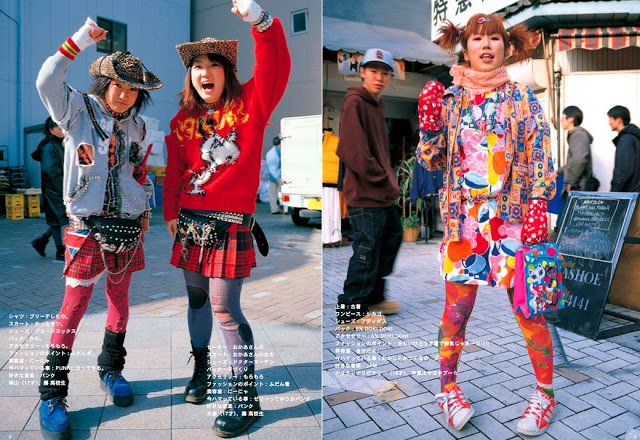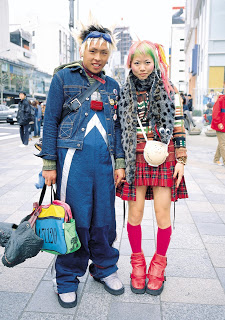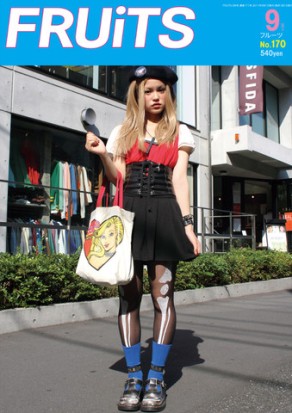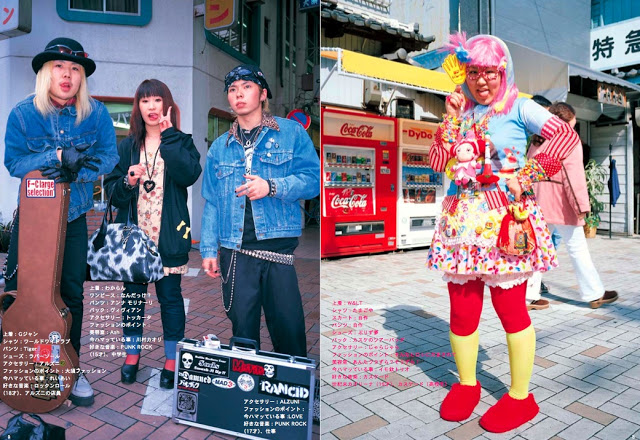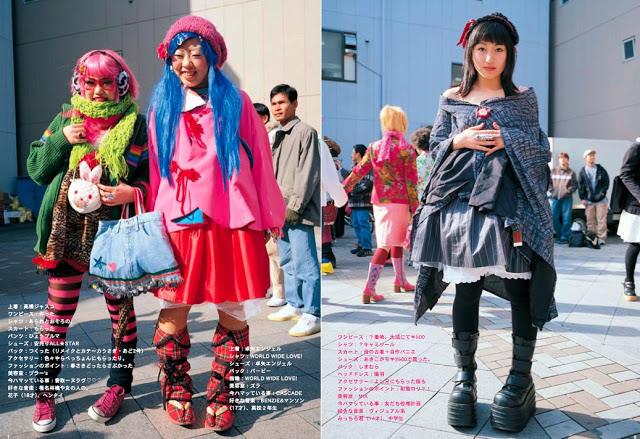Since 1996, a monthly magazine called FRUiTS has been documenting street fashion in the district of Harajuku in Tokyo.
What makes this fashion magazine different from any other is that it does not contain mainstream advertising (in fact, the only ads you’ll see at all are for shops around the area and for the magazine itself and its two affiliates, STREET and TUNE), and there are no models as such.
The photos are candid, the clothing worn by un-airbrushed people usually staring straight into the camera. Most pictures take up an entire page – only a small white bar at the bottom contains a description of the outfit, with a short bio of whoever is wearing it in their own words.
Both the readers and the people caught on camera tend to be in their teens and twenties, although it is not uncommon for FRUiTS to feature people from toddlers to their forties, and of both genders.
The style of clothing could be described as many things – crazy, eclectic, creative – but if anything, the only single aspect that holds each collection together is their individualism. It’s not a kind of cosplay, and there is no political agenda or set of ‘rules’ to follow; seemingly, the only point of the magazine is to highlight the fact that there are none when it comes to freedom of expression of Harajuku street fashion.
Photographer Aoki Shoichi first started documenting street fashion during his time in London in the mid 1980s.
He has described street fashion in the United Kingdom as being “free” and “cool” at this point, in comparison to the staleness of Japanese street fashion which was based primarily on whatever was considered trendy.
This motivated Aoki to begin publication of STREET, which showcased European and later on American street fashion, but also introduced the idea of clothing as art to Japanese teenagers.
When Japan’s bubble economy dramatically collapsed in 1991 it resulted in the nation’s ‘Lost Decade’, but this occurred alongside and perhaps even aided in fuelling a boom in a new and vibrant youth culture.
The main thoroughfare in Harajuku was closed off to vehicles every Sunday, when crowds of performers and street fashion devotees of every type imaginable would come to this “pedestrian paradise” simply to show off their own unique style.
Although this effectively ended in 1998 when the walkway was closed off by the city due to noise complaints, just a year after FRUiTS had begun publication, the magazine nonetheless became a cult hit among its readers.
Young people still flock to Harajuku every Sunday, congregating mostly on the pedestrian Jingu Bridge that connects Harajuku to the Meiji Shrine area in the neighboring ward of Shibuya.
Over recent years, FRUiTS has also become popular outside of Japan with those interested in the country’s pop culture, particularly with the release of Fruits and Fresh Fruits in 2001 and 2005 respectively – both compilation books made up of excerpts from the magazines (these can be found on shopping sites like Amazon and Book Depository). Exhibitions of Aoki’s photographs have also toured museums in Australia and New Zealand.
Today, FRUiTS continues its run as a magazine that Aoki has stated is “completely different [from the original FRUiTS] but the ideas and sense of style are the same.” Wildly different items of clothing are combined to create something entirely new, or are sewn together completely from scratch in a very DIY approach.
Although some photos depict a particular subculture such as Lolita or Decora, genres and styles more commonly collide in a riot of colour, pattern, or perspective. The idea is usually not about looking pretty or attractive in any conventional sense, but to counteract the pre-packaged fashion that could be bought in nearly any commercially mainstream store or out of most fashion magazines. The people in FRUiTS are not selling – simply showing.
As a result, it is difficult to generalise the overall ‘look’ of FRUiTS
fashion, if there is one at all. “They are much freer in expressing
themselves and can think for themselves. They even decide their own
hairstyles now”, says Aoki. “They don’t care at all about how other
people in society or how other groups see them.”
For this reason,
Harajuku has become known as one of the street fashion capitals of the
world, and has been promoted in other Japanese fashion magazines such as
Kera and Gothic & Lolita Bible. However, it is FRUiTS which has arguably had the most influence on the international recognition of and curiosity with Japanese street fashion as a whole.





































































































